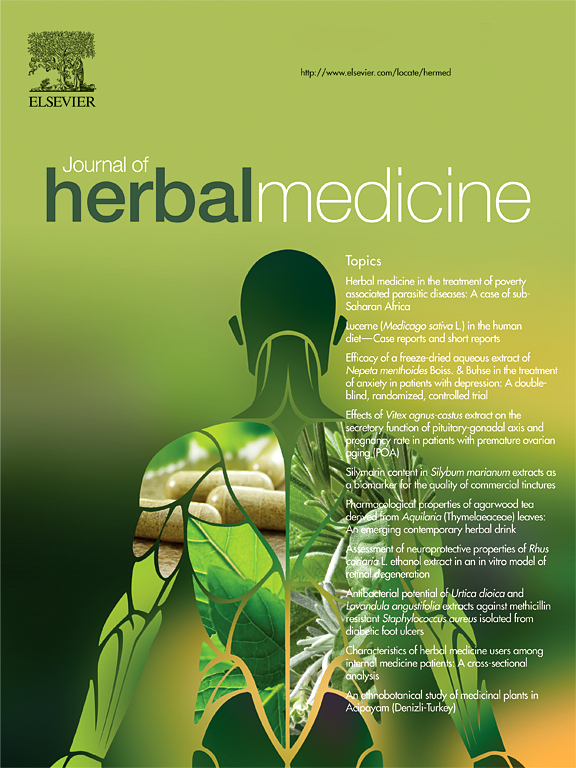The use of herbal medicine for cancer therapy in Indonesia: a prospective cohort study
IF 1.9
4区 医学
Q2 INTEGRATIVE & COMPLEMENTARY MEDICINE
引用次数: 0
Abstract
Introduction
Herbal medicine is widely used in Indonesia, including for cancer treatment, but data on its effectiveness is limited. This study aimed to assess the effectiveness of herbal medicine in cancer patients by evaluating their wellness index (WI), compliance, and herb usage patterns.
Methods
Data were obtained from the Jamu Registry for the period from 2014 to 2018. The improvement in patients' health status was assessed by quantifying the WI score, a modification of the World Health Organization's (WHO’s) quality of life (QoL) measure. Additionally, drug compliance and patterns of commonly used herbs were also evaluated.
Results
This study involved 130 participants, 82.3% of whom were female, with 33% diagnosed with breast cancer. Preference for herbal medicine alone was associated with older age, lower education, and rural residence. The six most commonly prescribed herbs were Andrographis paniculata, Catharanthus roseus, Curcuma zanthorrhiza, Gynura divaricata, Physalis angulata, and Centella asiatica. Overall, 75.4% of patients improved their WI score, with greater improvement in those using only herbal medicine (81.9%) compared to complementary therapies (48%) (P = 0.001). Drug compliance was good, with 72.3% adhering to their regimen. In silico analysis highlighted anti-cancer properties in these herbs, with α-tocopherol from P. angulata and kaempferol-3-O-β-D-glucopyranoside from G. divaricata showing potent effects, modulated by ERα and MDM2, both linked to breast cancer.
Conclusion
Herbal medicine is widely regarded as a complementary and alternative treatment option for cancer patients in Indonesia. Our study further demonstrates that the use of herbal medicine contributes to an improvement in the overall well-being of these patients.
在印度尼西亚使用草药治疗癌症:一项前瞻性队列研究
草药在印度尼西亚被广泛使用,包括用于癌症治疗,但是关于其有效性的数据有限。本研究旨在通过评估癌症患者的健康指数(WI)、依从性和草药使用模式来评估草药对癌症患者的有效性。方法数据来自2014 - 2018年的Jamu Registry。通过量化WI评分来评估患者健康状况的改善,WI评分是世界卫生组织(WHO)生活质量(QoL)衡量标准的一种修改。此外,还评估了常用草药的药物依从性和模式。该研究涉及130名参与者,其中82.3%为女性,其中33%被诊断患有乳腺癌。仅偏爱草药与年龄较大、受教育程度较低、居住在农村有关。最常用的六种草药是穿心莲、花楸花、花椒姜黄、花楸花、角Physalis和积雪草。总体而言,75.4%的患者改善了他们的WI评分,与补充疗法(48%)相比,仅使用草药的患者(81.9%)改善更大(P = 0.001)。药物依从性良好,72.3%的患者坚持服药。硅分析强调了这些草药的抗癌特性,其中角蒿中的α-生育酚和山奈酚-3- 0 -β- d -葡萄糖吡喃苷在ERα和MDM2的调节下显示出强有力的作用,两者都与乳腺癌有关。结论在印度尼西亚,草药被广泛认为是癌症患者的补充和替代治疗选择。我们的研究进一步表明,使用草药有助于改善这些患者的整体健康状况。
本文章由计算机程序翻译,如有差异,请以英文原文为准。
求助全文
约1分钟内获得全文
求助全文
来源期刊

Journal of Herbal Medicine
INTEGRATIVE & COMPLEMENTARY MEDICINE-
CiteScore
3.90
自引率
0.00%
发文量
94
期刊介绍:
The Journal of Herbal Medicine, the official journal of the National Institute of Medical Herbalists, is a peer reviewed journal which aims to serve its readers as an authoritative resource on the profession and practice of herbal medicine. The content areas of the journal reflect the interests of Medical Herbalists and other health professionals interested in the clinical and professional application of botanical medicines. The objective is to strengthen the research and educational base of herbal medicine with research papers in the form of case studies, original research articles and reviews, monographs, clinical trials and relevant in vitro studies. It also publishes policy statements, opinion pieces, book reviews, conference proceedings and profession related information such as pharmacovigilance reports providing an information source for not only the Herbal Practitioner but any Health professional with an interest in phytotherapy.
 求助内容:
求助内容: 应助结果提醒方式:
应助结果提醒方式:


